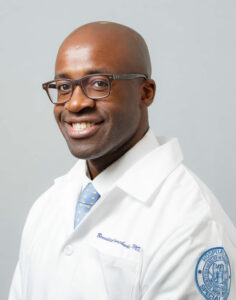Shoulder Labrum and SLAP Tear Specialist

Are you an athlete who participates in sports that involve throwing overhead? If so, you may be at risk of developing a shoulder labral tear or a SLAP tear. Shoulder labral tears and SLAP tears are common injuries sustained after a fall on an outstretched hand, from a sports injury or from natural degeneration of the labrum. Shoulder labral specialist, Doctor Benedict Nwachukwu provides diagnosis as well as surgical and nonsurgical treatment options for patients in Manhattan, New York City, NY who have labral or SLAP tears in the shoulder. Contact Dr. Nwachukwu’s team today!
What is a labral tear in the shoulder?
The labrum, also called the glenoid labrum is a type of cartilage found in the shoulder at the base of the shoulder joint. The labrum’s job is to deepen the shoulder socket and to provide extra support for the joint, keeping the ball of the humerus, firmly within the cup of the glenoid. Often compared to a golf tee, the rubbery top rim of the labrum holds the ball in place. The labrum also doubles as an attachment site for the biceps tendon and shoulder ligaments. If the labrum is injured either from a trauma or a dislocation, the labrum cartilage can peel off of the rim of the shoulder socket. This tearing away of the cartilage is called a labral tear. Patients in Manhattan, New York City and the surrounding New York boroughs who have experienced a labral tear can be treated by Dr. Benedict Nwachukwu, orthopedic shoulder specialist. He provides the best and most up-to-date orthopedic care in the area and has extensive experience in treating patients with shoulder pain and labral tears.
What is a SLAP tear in the shoulder?
A SLAP tear is also called a Superior Labrum Anterior and Posterior tear. SLAP is the acronym that simply refers to the location of the labral tear: the top of the shoulder socket, and involves the attachments site of the biceps tendon. SLAP tears occur in both the front and the back of the attachment point of the tendon (anterior and posterior, respectively). Overuse of the shoulder and acute trauma are usually the main culprits in SLAP tears.
What causes a labral or SLAP tear?
Injury to the labrum can be caused by repetitive motions, or by acute trauma. These types of tears most often result from:
- An automobile accident
- A fall onto an outstretched arm
- Shoulder dislocation
- A significant pull on the arm or shoulder (traction injury)
- Overuse – especially repeated overhead motions
- Wear and tear – the labrum can break down from continuous motions
- Age – the labrum becomes brittle and less flexible with age, especially in patients over 50
What are the symptoms of a Labral or SLAP tear?
- Decreased range of motion
- Stiffness in then joint
- Pain in the shoulder joint, often felt in the back of the shoulder
- Pain with overhead motion
- A popping or clicking sensation
- Weakness in the joint, often more on one side than the other
- Instability, feeling that the shoulder will “pop out” of joint
- Pain while holding the shoulder in specific positions
How is a SLAP tear or a labral tear diagnosed?
Dr. Nwachukwu has extensive experience in diagnosing and treating labral and SLAP tears. For patients in the New York area he will conduct a through examination to determine if there is a labral or SLAP tear or if other injuries are present. During the examination, he will discuss any prior injury, work responsibilities and instability that might be associated with the symptoms. Most often an MRI scan will be used to help identify a possible labral tear, the location and other shoulder structures involved. Once a diagnosis is made, Dr. Nwachukwu will discuss treatment options based on the patient’s age, level of activity, prior treatment and type of tear.
How are shoulder labrum and SLAP tears treated?
Non-surgical treatment:
In many cases the initial treatment for a labral tear or a SLAP tear is non-surgical. Treatments may include:
- Rest
- Anti-inflammatory medication
- Corticosteroid Injection
- Physical therapy
- Stretching exercises
Surgical Treatment:
If conservative treatments fail to provide patients in New York with pain relief and full function, surgery may be needed. Dr. Nwachukwu prefers a non-invasive type of treatment called arthroscopic surgery using a small surgical camera and small instruments to perform one or more of the following:
- Debridement: Debridement is done within the joint and smooths out the jagged edges of the torn labrum. Sometimes called “shaving” or “trimming” this surgery is used when the biceps tendon is not involved and the tear is stable (not at risk of dislocation)
- SLAP Repair: Performed on patients who wish to remain active in overhead work or sports who have an otherwise healthy shoulder. This involves reattaching the labrum to the shoulder socket at the site of biceps attachment. This procedure is done using strong sutures.
- Labrum Repair: The remaining labrum beyond the area of the biceps attachment may need to be repaired and re-attached to the glenoid cavity using strong sutures or anchors. This procedure is used when the shoulder is unstable and has a greater risk for dislocation.
- Biceps Tenodesis: An alternative treatment for painful SLAP tears that are associated with the biceps deforming the labrum. As part of this procedure, the injured biceps tendon is removed from where it normally resides, inside the shoulder joint, and is reattached to bone outside of the joint. With this procedure, the pain generator inside the shoulder joint is removed and the deforming force on the labrum is also removed.
For more information on Labral and SLAP tears, shoulder pain and your treatment options, please contact the office of Benedict Nwachukwu, MD, orthopedic shoulder specialist serving Manhattan, New York City and surrounding New York boroughs.





